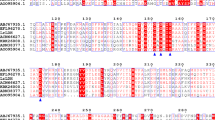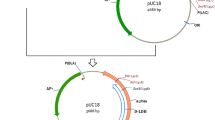Abstract
Lactate are proved to be attractive electron donor for the production of n-caproic acid (CA) that is a high value-added fuel precursor and chemical feedstock, but little is known about molecular mechanism of lactate transformation. In the present study, the gene for L-lactate dehydrogenase (LDH, EC.1.1.1.27) from a Ruminococcaceae strain CPB6 was cloned and expressed in Escherichia coli BL21 (DE3) with plasmid pET28a. The recombinant LDH exhibited molecular weight of 36–38 kDa in SDS-PAGE. The purified LDH was found to have the maximal oxidation activity of 29.6 U/mg from lactate to pyruvate at pH 6.5, and the maximal reduction activity of 10.4 U/mg from pyruvate to lactate at pH 8.5, respectively. Strikingly, its oxidative activity predominates over reductive activity, leading to a 17-fold increase for the utilization of lactate in E. coli/pET28a-LDH than E. coli/pET28a. The CPB6 LDH gene encodes a 315 amino acid protein sharing 42.19% similarity with Clostridium beijerinckii LDH, and lower similarity with LDHs of other organisms. Significant difference were observed between the CPB6 LDH and C. beijerinckii and C. acetobutylicum LDH in the predicted tertiary structure and active center. Further, X-ray crystal structure analysis need to be performed to verify the specific active center of the CPB6 LDH and its role in the conversion of lactate into CA.





Similar content being viewed by others
References
Agler MT, Spirito CM, Usack JG, Werner JJ, Angenent LT (2012) Chain elongation with reactor microbiomes: upgrading dilute ethanol to medium-chain carboxylates. Energy Environ Sci 5:8189–8192
Andersen SJ, De Groof V, Khor WC, Roume H, Props R, Coma M, Rabaey K (2017) A Clostridium Group IV species dominates and suppresses a mixed culture fermentation by tolerance to medium chain fatty acids products. Front Bioeng Biotechnol 5:1–10
Arnold K, Bordoli L, Kopp J, Schwede T (2006) The SWISS-MODEL workspace: a web-based environment for protein structure homology modelling. Bioinformatics 22:195–201
Cavalcante WDA, Leitão RC, Gehring TA, Angenent LT, Santaella ST (2017) Anaerobic fermentation for n-caproic acid production: a review. Process Biochem 54:106–119
Chen WS, Ye Y, Steinbusch KJJ, Strik DPBTB, Buisman CJN (2016) Methanol as an alternative electron donor in chain elongation for butyrate and caproate formation. Biomass Bioenerg 93:201–208
Collins SS, Keeton JT, Smith SB (1991) Lactate dehydrogenase enzyme activity in raw, cured, and heated porcine muscle. J Agric Food Chem 39:1294–1297
Contag PR, Williams MG, Rogers P (1990) Cloning of a lactate dehydrogenase gene from Clostridium acetobutylicum B643 and expression in Escherichia coli. Appl Environ Microbiol 56:3760–3765
Cuff JA, Barton GJ (2000) Application of multiple sequence alignment profiles to improve protein secondary structure prediction. Proteins 40:502–511
Dietrich C, Nato A, Bost B, Le Marechal P, Guyonvarch A (2009) Regulation of ldh expression during biotin-limited growth of Corynebacterium glutamicum. Microbiology 155:1360–1375
Dong H, Wang Y, Zhao Q, Han H, Zhu S, Li L, Wu Y, Huang B (2014) Molecular cloning and characterization of lactate dehydrogenase gene from Eimeria tenella. Parasitol Res 113:2915–2923
Evans JD, Martin SA (2002) Cloning of the L-lactate dehydrogenase gene from the ruminal bacterium Selenomonasruminantium HD4. Curr Microbiol 44:155–160
Fu Y, Sun X, Zhu H, Jiang R, Luo X, Yin L (2018) An optimized fed-batch culture strategy integrated with a one-step fermentation improves L-lactic acid production by Rhizopusoryzae. World J Microbiol Biotechnol 34:74–82
Gaspar P, Neves AR, Ramos A, Gasson MJ, Shearman CA, Santos H (2004) Engineering Lactococcuslactis for production of mannitol: high yields from food-grade strains deficient in lactate dehydrogenase and the mannitol transport system. Appl Environ Microbiol 70:1466–1474
Gokarn RR, Eiteman MA, Altman E (2000) Metabolic analysis of Escherichiacoli in the presence and absence of the carboxylating enzymes phosphoenolpyruvate carboxylase and pyruvate carboxylase. Appl Environ Microbiol 66:1844–1850
Hahnke S, Abendroth C, Langer T, Codoner FM, Ramm P, Porcar M, Luschnig O, Klocke M (2018) Complete genome sequence of a new ruminococcaceae bacterium isolated from anaerobic biomass hydrolysis. Genome Announc 6:1–2
Hannenhalli SS, Russell RB (2000) Analysis and prediction of functional sub-types from protein sequence alignments. J Mol Biol 303:61–76
Kim SG, Jang S, Lim JH, Jeon BS, Kim J, Kim KH, Sang BI, Jung GY (2018) Optimization of hexanoic acid production in recombinant Escherichiacoli by precise flux rebalancing. Bioresour Technol 247:1253–1257
Kouassi GK, Anantheswaran RC, Knabel SJ, Floros JD (2007) Effect of high-pressure processing on activity and structure of alkaline phosphatase and lactate dehydrogenase in buffer and milk. J Agric Food Chem 55:9520–9529
Kucek LA, Nguyen M, Angenent LT (2016) Conversion of L-lactate into n-caproate by a continuously fed reactor microbiome. Water Res 93:163–171
Lee JH, Choi MH, Park JY, Kang HK, Ryu HW, Sunwo CS, Wee YJ, Park KD, Kim DW, Kim D (2004) Cloning and characterization of the lactate dehydrogenase genes from Lactobacillus sp. RKY2. Biotechnol Bioprocess Eng 9:318–322
Li X (2008) Purification and partial characterization of Lactobacillus species SK007 lactate dehydrogenase (LDH) catalyzing phenylpyruvic acid (PPA) conversion into phenyllactic acid (PLA). J Agric Food Chem 56:2392–2399
Louis P, Flint HJ (2009) Diversity, metabolism and microbial ecology of butyrate-producing bacteria from the human large intestine. FEMS Microbiol Lett 294:1–8
Lu G, Hu X, Peng Z, Xie H, Li Y, Wu Z, Yu X (2006) Expression and characterization of lactate dehydrogenase from Schistosomajaponicum. Parasitol Res 99:593–596
Marchler-Bauer A, Anderson JB, Chitsaz F, Derbyshire MK, DeWeese-Scott C, Fong JH, Geer LY, Geer RC, Gonzales NR, Gwadz M, He S, Hurwitz DI, Jackson JD, Ke Z, Lanczycki CJ, Liebert CA, Liu C, Lu F, Lu S, Marchler GH, Mullokandov M, Song JS, Tasneem A, Thanki N, Yamashita RA, Zhang D, Zhang N, Bryant SH (2009) CDD: specific functional annotation with the Conserved Domain Database. Nucleic Acids Res 37:D205-210
Nadeem MS, Al-Ghamdi MA, Khan JA, Sadath S, Al-Malki A (2018) Recombinant production and biochemical and in silico characterization of lactate dehydrogenase from Geobacillus thermodenitrificans DSM-465. Electron J Biotechnol 35:18–24
Nolling J, Breton G, Omelchenko MV, Makarova KS, Zeng Q, Gibson R, Lee HM, Dubois J, Qiu D, Hitti J, Wolf YI, Tatusov RL, Sabathe F, Doucette-Stamm L, Soucaille P, Daly MJ, Bennett GN, Koonin EV, Smith DR (2001) Genome sequence and comparative analysis of the solvent-producing bacterium Clostridiumacetobutylicum. J Bacteriol 183:4823–4838
Özkan M, Yllmaz EI, Lynd LR, Özcengiz G (2004) Cloning and expression of the Clostridiumthermocellum L-lactate dehydrogenase gene in Escherichiacoli and enzyme characterization1. Can J Microbiol 50:845–851
Ozkan M, Erhan E, Terzi O, Tan I, Ozoner SK (2009) Thermostable amperometric lactate biosensor with Clostridiumthermocellum L-LDH for the measurement of blood lactate. Talanta 79:1412–1417
Scott KP, Martin JC, Mrazek J, Flint HJ (2008) Transfer of conjugative elements from rumen and human Firmicutes bacteria to Roseburiainulinivorans. Appl Environ Microbiol 74:3915–3917
Sharkey MA, Maher MA, Guyonvarch A, Engel PC (2011) Kinetic characterisation of recombinant Corynebacterium glutamicum NAD+-dependent LDH over-expressed in E. coli and its rescue of an lldD- phenotype in C. glutamicum: the issue of reversibility re-examined. Arch Microbiol 193:731–740
Singh V, Kaushal DC, Rathaur S, Kumar N, Kaushal NA (2012) Cloning, overexpression, purification and characterization of Plasmodium knowlesi lactate dehydrogenase. Protein Expr Purif 84:195–203
Singhvi M, Zendo T, Iida H, Gokhale D, Sonomoto K (2017) Stimulation of d- and l-lactate dehydrogenases transcriptional levels in presence of diammonium hydrogen phosphate resulting to enhanced lactic acid production by Lactobacillus strain. J Biosci Bioeng 124:674–679
Skory CD (2000) Isolation and expression of lactate dehydrogenase genes from Rhizopusoryzae. Appl Environ Microbiol 66:2343–2348
Stevenson DM, Weimer PJ (2005) Expression of 17 genes in Clostridiumthermocellum ATCC 27405 during fermentation of cellulose or cellobiose in continuous culture. Appl Environ Microbiol 71:4672–4678
Sun L, Zhang C, Lyu P, Wang Y, Wang L, Yu B (2016) Contributory roles of two l-lactate dehydrogenases for l-lactic acid production in thermotolerant Bacilluscoagulans. Sci Rep 6:37916–37923
Tamura K, Peterson D, Peterson N, Stecher G, Nei M, Kumar S (2011) MEGA5: molecular evolutionary genetics analysis using maximum likelihood, evolutionary distance, and maximum parsimony methods. Mol Biol Evol 28:2731–2739
Tao Y, Hu X, Zhu X, Jin H, Xu Z, Tang Q, Li X (2016) Production of butyrate from lactate by a newly isolated Clostridium sp. BPY5. Appl Biochem Biotechnol 179:361–374
Tao Y, Zhu X, Wang H, Wang Y, Li X, Jin H, Ru J (2017) Complete genome sequence of Ruminococcaceae bacterium CPB6: a newly isolated culture for efficient n-caproic acid production from lactate. J Biotechnol 259:91–94
Tebianian M, Hoseini AZ, Ebrahimi SM, Memarnejadian A, Mokarram AR, Mahdavi M, Sohrabi N, Taghizadeh M (2011) Cloning, expression, and immunogenicity of novel fusion protein of Mycobacterium tuberculosis based on ESAT-6 and truncated C-terminal fragment of HSP70. Biologicals 39:143–148
Toth J, Ismaiel AA, Chen JS (1999) The ald gene, encoding a coenzyme A-acylating aldehyde dehydrogenase, distinguishes Clostridiumbeijerinckii and two other solvent-producing Clostridia from Clostridiumacetobutylicum. Appl Environ Microbiol 65:4973–4980
Wang Y, Li X, Milne CB, Janssen H, Lin W, Phan G, Huiying Hu, Jin Y-S (2013) Development of a gene knockout system using mobile Group II Introns (Targetron) and genetic disruption of acid production pathways in Clostridiumbeijerinckii. Appl Environ Microbiol 79:5853–5863
Wang H, Li X, Wang Y, Tao Y, Lu S, Zhu X, Li D (2018) Improvement of n-caproic acid production with Ruminococcaceae bacterium CPB6: selection of electron acceptors and carbon sources and optimization of the culture medium. Microb Cell Fact 17:99–108
Wang P, Zhang J, Feng J, Wang S, Guo L, Wang Y, Lee YY, Taylor S, McDonald T, Wang Y (2019) Enhancement of acid re-assimilation and biosolvent production in Clostridiumsaccharoperbutylacetonicum through metabolic engineering for efficient biofuel production from lignocellulosic biomass. Bioresour Technol 281:217–225
Wu Q, Bao X, Guo W, Wang B, Li Y, Luo H, Wang H, Ren N (2019) Medium chain carboxylic acids production from waste biomass: current advances and perspectives. Biotechnol Adv 37:599–615
Xiao Y, Francke C, Abee T, Wells-Bennik MHJ (2011) Clostridial spore germination versus bacilli: genome mining and current insights. Food Microbiol 28:266–274
Zhang QL, Yang M, Zhao YY, Zhang SZ, He QH, Meng XY, Tan WR (2014) Cloning and characterization of lactate dehydrogenase C4 from Ochotonacurzoniae. Mol Biol 48:105–112
Zhou Q, Shao WL (2010) Molecular genetic characterization of the thermostable L-lactate dehydrogenase gene (ldhL) of Thermoanaerobacterethanolicus JW200 and biochemical characterization of the enzyme. Biochemistry (Mosc) 75:526–530
Zhou S, Shanmugam KT, Ingram LO (2003) Functional replacement of the Escherichiacoli D-(-)-lactate dehydrogenase gene (ldhA) with the L-(+)-lactate dehydrogenase gene (ldhL) from Pediococcusacidilactici. Appl Environ Microbiol 69:2237–2244
Zhu X, Tao Y, Liang C, Li X, Wei N, Zhang W, Zhou Y, Yang Y, Bo T (2015) The synthesis of n-caproate from lactate: a new efficient process for medium-chain carboxylates production. Sci Rep 5:14360–14369
Zhu X, Zhou Y, Wang Y, Wu T, Li X, Li D, Tao Y (2017) Production of high-concentration n-caproic acid from lactate through fermentation using a newly isolated Ruminococcaceae bacterium CPB6. Biotechnol Biofuels 10:102–114
Zoraghi R, See RH, Gong H, Lian T, Swayze R, Finlay BB, Brunham RC, McMaster WR, Reiner NE (2010) Functional analysis, overexpression, and kinetic characterization of pyruvate kinase from methicillin-resistant Staphylococcusaureus. Biochemistry 49:7733–7747
Acknowledgements
This work was financially supported by the Natural Science Foundation of China (Grant No. 31770090), the Open-foundation project of CAS Key Laboratory of Environmental and Applied Microbiology (KLCAS-2017-01).
Author information
Authors and Affiliations
Corresponding author
Ethics declarations
Conflict of interest
The authors declare no competing interests.
Additional information
Publisher's Note
Springer Nature remains neutral with regard to jurisdictional claims in published maps and institutional affiliations.
Electronic supplementary material
Below is the link to the electronic supplementary material.
Rights and permissions
About this article
Cite this article
Yang, Q., Wei, C., Guo, S. et al. Cloning and characterization of a l-lactate dehydrogenase gene from Ruminococcaceae bacterium CPB6. World J Microbiol Biotechnol 36, 182 (2020). https://doi.org/10.1007/s11274-020-02958-4
Received:
Accepted:
Published:
DOI: https://doi.org/10.1007/s11274-020-02958-4




